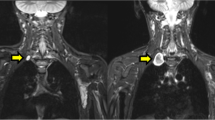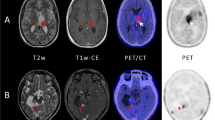Abstract
Purpose
There is little consensus regarding optimal surveillance of optic pathway glioma (OPG) and plexiform neurofibroma (PNF) in childhood neurofibromatosis type 1 (NF1). 18F-2-Fluoro-2-deoxy-D-glucose (FDG) positron emission tomography and computed tomography (PET/CT) is employed in the surveillance of adult PNFs; but its utility has neither been specifically studied in children with PNFs nor in children with OPG.
Methods
Review of PET/CT studies was performed in NF1 children with OPG or PNF. FDG-avidity of tumours was semi-quantitatively analysed and graded by calculating the maximum standardised uptake value (SUVmax) [grade 1: <3 (low), grade 2: >3–<4 (intermediate), grade 3: >4 (intense)].
Results
Eighteen children (ten girls; median age: 8.5–years) had PET/CT. Nineteen OPGs were imaged. The SUVmax could be measured in 16. Ten were grade 1 and three each were grade 2 and grade 3. FDG-avidity reduced from grade 3 to grade 1 in two symptomatic OPGs following chemotherapy and this was associated with clinical improvement. PET/CT diagnosed symptomatic OPGs with a sensitivity of 0.625 [95% confidence interval (CI): 0.259–0.897] and specificity of 0.875 (95% CI: 0.466–0.993). Sixteen PNFs were imaged. Twelve were grade 1 and two each were grade 2 and grade 3. The two grade 3 PNFs were confirmed malignant peripheral nerve sheath tumours. PET/CT diagnosed malignant transformation with a sensitivity of 1.0 (95% CI: 0.197–1.0) and specificity of 0.857 (95% CI: 0.561–0.974).
Conclusion
PET/CT may contribute useful information to the surveillance of OPG in childhood NF1—particularly to identify progressive, symptomatic tumours. As in adults, PET/CT is useful for the detection of malignant transformation in PNFs in children with NF1.



Similar content being viewed by others
References
Huson SM, Harper PS, Compston DAS. Von Recklinghausen neurofibromatosis. A clinical and population study in south-east Wales. Brain 1988;111:1355–81.
No authors listed. National Institutes of Health Consensus Development Conference Statement: neurofibromatosis. Bethesda, Md., USA, July 13–15, 1987. Neurofibromatosis 1988;1(3):172–8.
Lau N, Feldkamp MM, Roncari L, Loehr AH, Shannon P, Gutmann DH, et al. Loss of neurofibromin is associated with activation of RAS/MAPK and P13-K/AKT signaling in a neurofibromatosis 1 astrocytoma. J Neuropathol Exp Neurol 2000;59:759–67.
Listernick R, Ferner RE, Liu GT, Gutmann DH. Optic pathway gliomas in neurofibromatosis-1: controversies and recommendations. Ann Neurol 2007;61:189–98.
Packer RJ, Gutmann DH, Rubenstein A, Viskochil D, Zimmerman RA, Vezina G, et al. Plexiform neurofibromas in NF1, toward biologic-based therapy. Neurology 2002;58:1461–70.
Ferner RE, Lucas JD, O’Doherty MJ, Hughes RAC, Smith MA, Cronin BF, et al. Evaluation of (18)fluorodeoxyglucose positron emission tomography ((18)FDG PET) in the detection of malignant peripheral nerve sheath tumours arising from plexiform neurofibromas in neurofibromatosis 1. J Neurol Neurosurg Psychiatry 2000;68:353–7.
Gelfand MJ, Lemen LC. PET/CT and SPECT/CT dosimetry in children: the challenge to the pediatric imager. Semin Nucl Med 2007;37:391–8.
Barrington SF, Begent J, Lynch T, Schleyer P, Biassoni L, Ramsden W, et al. Guidelines for the use of PET-CT in children. Nucl Med Commun 2008;29:418–24.
The Administration of Radioactive Substances Advisory Committee. http://www.arsac.org.uk/notes_for_guidance
Ferner RE, Golding JF, Smith M, Calonje E, Jan W, Sanjayanathan V, et al. [18F]2-fluoro-2-deoxy-D-glucose positron emission tomography (FDG PET) as a diagnostic tool for neurofibromatosis 1 (NF1) associated malignant peripheral nerve sheath tumours (MPNSTs): a long-term clinical study. Ann Oncol 2008;19:390–4.
Brenner W, Friedrich RE, Gawad KA, Hagel C, von Deimling A, de Wit M, et al. Prognostic relevance of FDG PET in patients with neurofibromatosis type-1 and malignant peripheral nerve sheath tumours. Eur J Nucl Med Mol Imaging 2006;33:428–32.
Balestri P, Lucignani G, Fois A, Magliani L, Callistri L, Grana C, et al. Cerebral glucose metabolism in neurofibromatosis type 1 assessed with [18F]-2-fluoro-2-deoxy-D-glucose and PET. J Neurol Neurosurg Psychiatry 1994;57:1479–83.
Kaplan AM, Chen K, Lawson M, Wodrich DL, Bonstelle CT, Reiman EM. Positron emission tomography in children with neurofibromatosis-1. J Child Neurol 1997;12:499–506.
Peng F, Juhasz C, Bhambhani K, Wu D, Chugani DC, Chugani HT. Assessment of progression and treatment response of optic pathway glioma with positron emission tomography using alpha-[(11)C]methyl-L-tryptophan. Mol Imaging Biol 2007;9:106–9.
Miyamoto J, Sasajima H, Owada K, Mineura K. Surgical decision for adult optic glioma based on [18F]fluorodeoxyglucose positron emission tomography study. Neurol Med Chir (Tokyo) 2006;46(10):500–3.
Kleihues P, Louis DN, Scheithauer BW, Rorke LB, Reifenberger G, Burger PC, et al. The WHO classification of tumors of the nervous system. J Neuropathol Exp Neurol 2002;61:215–25.
Leonard JR, Perry A, Rubin JB, King AA, Chicoine MR, Gutmann DH. The role of surgical biopsy in the diagnosis of glioma in individuals with neurofibromatosis-1. Neurology 2006;67:1509–12.
Fulham MJ, Melisi JW, Nishimiya J, Dwyer AJ, Di Chiro G. Neuroimaging of juvenile pilocytic astrocytomas: an enigma. Radiology 1993;189(1):221–5.
Robinson RO, Ferrie CD, Capra M, Maisey MN. Positron emission tomography and the central nervous system. Arch Dis Child 1999;81:263–70.
Listernick R, Ferner RE, Piersall L, Sharif S, Gutmann DH, Charrow J. Late-onset optic pathway tumors in children with neurofibromatosis 1. Neurology 2004;63(10):1944–6.
Warbey VS, Ferner RE, Dunn JT, Calonje E, O’Doherty MJ. [18F]FDG PET/CT in the diagnosis of malignant peripheral nerve sheath tumours in neurofibromatosis type-1. Eur J Nucl Med Mol Imaging 2009;36:751–7.
Author information
Authors and Affiliations
Corresponding author
Rights and permissions
About this article
Cite this article
Moharir, M., London, K., Howman-Giles, R. et al. Utility of positron emission tomography for tumour surveillance in children with neurofibromatosis type 1. Eur J Nucl Med Mol Imaging 37, 1309–1317 (2010). https://doi.org/10.1007/s00259-010-1386-4
Received:
Accepted:
Published:
Issue Date:
DOI: https://doi.org/10.1007/s00259-010-1386-4




